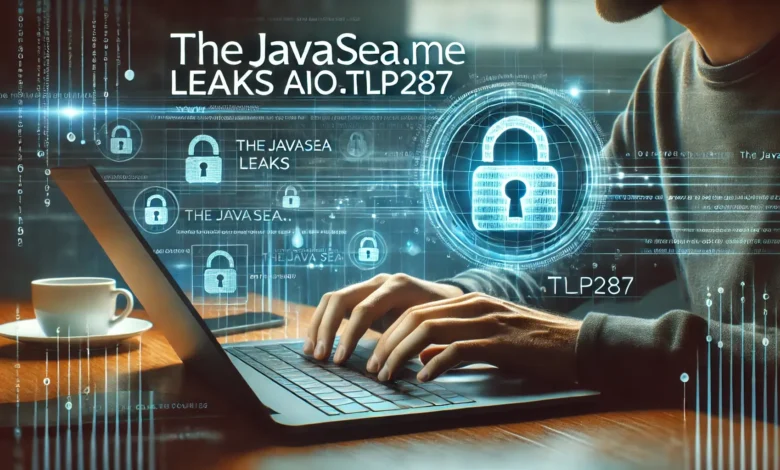Thejavasea.me Leaks AIO-TLP287 Everything You Need to Know

The internet is an ever-evolving space, and with it comes the growing concern of data breaches and leaks. One such incident that has garnered significant attention is Thejavasea.me Leaks AIO-TLP287. This breach has sparked discussions regarding online security, privacy risks, and how individuals and businesses can protect themselves from similar threats.
In this comprehensive article, we will explore everything about Thejavasea.me Leaks AIO-TLP287, including its origins, possible consequences, and preventive measures to ensure data safety.
What is Thejavasea.me Leaks AIO-TLP287?
Thejavasea.me Leaks AIO-TLP287 is believed to be a major data leak incident involving a vast amount of sensitive information. The name itself suggests that it is associated with Thejavasea.me, a platform that may have been compromised or has played a role in hosting leaked data.
While specific details about the leak remain unclear, such leaks often include information such as:
- Personal user data (emails, passwords, financial details)
- Confidential business records
- Sensitive government or corporate communications
- Intellectual property and proprietary content
How Did Thejavasea.me Leaks AIO-TLP287 Happen?
Cybersecurity experts suggest that data leaks like Thejavasea.me Leaks AIO-TLP287 can occur due to various reasons. Some of the most common causes include:
1. Hacking and Cyberattacks
Hackers often target databases with weak security measures. If Thejavasea.me had vulnerabilities, cybercriminals could have exploited them to gain access to sensitive data.
2. Insider Threats
Sometimes, employees or individuals with access to confidential information leak data intentionally or unintentionally. Insider threats are a major concern for organizations.
3. Phishing Attacks
Phishing emails and malicious links trick users into providing their credentials, which can lead to unauthorized access to data.
4. Weak Security Measures
Poorly secured websites and databases are easy targets for cybercriminals. If Thejavasea.me had inadequate encryption or outdated security measures, it could have led to the leak.
Potential Consequences of Thejavasea.me Leaks AIO-TLP287
Data breaches such as Thejavasea.me Leaks AIO-TLP287 can have severe consequences for individuals and organizations. Some of the key impacts include:
1. Identity Theft and Financial Fraud
If personal information such as credit card details, banking information, or social security numbers are exposed, users can become victims of identity theft and financial fraud.
2. Privacy Violations
Leaked personal data can lead to privacy violations, exposing individuals to cyberstalking, harassment, or even blackmail.
3. Reputational Damage
Businesses and organizations linked to such leaks may suffer significant reputational damage, leading to loss of customer trust and potential legal consequences.
4. Legal and Regulatory Consequences
Organizations responsible for handling sensitive data can face lawsuits and hefty fines if they fail to protect their users’ information adequately.
How to Protect Yourself from Data Leaks
While no security measure is foolproof, taking proactive steps can minimize the risk of being affected by incidents like Thejavasea.me Leaks AIO-TLP287.
1. Use Strong and Unique Passwords
Ensure that you use strong, unique passwords for different accounts. Consider using a password manager to keep track of them.
2. Enable Two-Factor Authentication (2FA)
2FA adds an extra layer of security by requiring additional verification steps before accessing an account.
3. Be Cautious with Emails and Links
Avoid clicking on suspicious links or downloading attachments from unknown senders. Phishing scams are one of the leading causes of data breaches.
4. Keep Software and Systems Updated
Regularly update your operating system, applications, and security software to patch vulnerabilities.
5. Monitor Your Online Accounts
Regularly check your online accounts for any suspicious activity. Consider using identity theft protection services to receive alerts about potential breaches.
Steps Organizations Can Take to Prevent Data Breaches
1. Implement Strong Encryption
Encrypting sensitive data ensures that even if it is compromised, unauthorized individuals cannot easily access it.
2. Conduct Regular Security Audits
Frequent security assessments help identify and fix vulnerabilities before they can be exploited.
3. Train Employees on Cybersecurity Best Practices
Human error is a significant factor in data breaches. Educating employees about cybersecurity threats and best practices can reduce risks.
4. Limit Access to Sensitive Data
Implementing strict access controls ensures that only authorized personnel can view or modify sensitive information.
5. Have an Incident Response Plan
A well-defined incident response plan helps organizations quickly detect, contain, and mitigate the effects of data breaches.
FAQs About Thejavasea.me Leaks AIO-TLP287
1. What is Thejavasea.me Leaks AIO-TLP287?
Thejavasea.me Leaks AIO-TLP287 refers to a significant data leak possibly associated with the website Thejavasea.me, involving the exposure of sensitive personal or business information.
2. How Can I Check If My Data Was Affected?
You can use online tools like “Have I Been Pwned” to check if your email or credentials were part of the leak.
3. What Should I Do If My Data Is Compromised?
Immediately change your passwords, enable 2FA, and monitor your financial accounts for suspicious activity.
4. Can Organizations Be Held Liable for Data Breaches?
Yes, depending on the jurisdiction, organizations can face legal consequences if they fail to protect user data adequately.
5. How Can I Prevent Future Data Leaks?
Practicing good cybersecurity habits, such as using strong passwords, enabling 2FA, and staying vigilant against phishing scams, can help prevent future data leaks.
Conclusion
The internet is a powerful tool, but it also comes with risks, including data breaches like Thejavasea.me Leaks AIO-TLP287. By understanding how such leaks occur and taking proactive measures, both individuals and organizations can enhance their online security and minimize the risk of data exposure.



